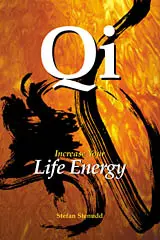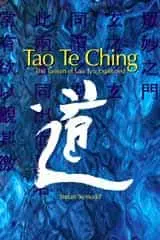Qi Extension Exercise 1

Gaze
To look is certainly nothing exotic. Man trusts his vision more than any other means of perception, and uses it constantly, without reflecting much on it. But in the following, you will exercise another way of looking. I call it gazing, in order to distinguish it from regular looking. That is all I intend with my choice of word.
The Book
The life energy qi (also chi or ki) explained, with several very easy exercises to awaken, increase, and use it. Click the image to see the book at Amazon (paid link).
|
There are several different ways of looking, no doubt, and this has been noted for ages. It is marked by the many words used for the activity of the eyes, such as: watch, see, gaze, stare, observe, spot, glimpse, glance, ogle, eyeball, view, peep, peek, glare, and so on. Even more is implied with expressions like ‘seeing through’ or clairvoyance. Such grand perspectives are not applied here, but you will feel that a new way of looking emerges through this exercise. At least, it will give new clarity to whatever object you lay your eyes on.
How to do it
- In this exercise you should sit or stand. If you lie down you see nothing but the ceiling, or the sky if you are outdoors, which is a bit monotonous. Apart from that, there is not much you need to consider.
- Direct your head and your eyes toward an abject or a spot in front of you. Not something too near to you. The distance should be at least some ten feet, but as far away as possible is fine, as long as you can see the object clearly. Make sure that you know exactly what spot you are looking at, not just a large surface on which your eyes might start to wander.
- Close your eyes and breathe calmly and deeply, focused on qi breathing – the flow in and out that is not air. Do this for a while before you move to the next step, so that you feel that you have a good qi flow going.
- Commence a long exhalation through your nose and open your eyes when your exhalation flows steadily – but long before it ends. Look straight at the spot you had decided on, and continue breathing out. You can go on with the exhalation without air, described in the exercise to breathe in a square – but only if you feel that you can do it with conviction.
- Before the feeling of exhalation weakens, close your eyes again. This is to avoid losing concentration, or landing on an unclear moment between exhalation and inhalation. It is important that you close your eyes while your breath still feels powerful.
- Once is never. Take a few deep and calm breaths, and then repeat the exercise, exhaling and gazing at that spot anew. Remember to close your eyes before your exhalation weakens.
- Continue as long as you feel that it gives you something. When you repeat the exercise, it will feel more and more like your exhalation goes through your eyes and all the way to the spot you aim at, as if your breath exits through your eyes and reaches that spot. The breath that travels this way is qi, of course. It makes you perceive the spot with a clarity that the eyes alone would not manage. It is as if you reach that spot, no matter how far away it is.
Contrary to regular breathing, qi can flow in any direction inside and outside your body. In this exercise, qi actually flows through your eyes and forward in the direction you look. When you have trained this more, it will feel like your gaze follows qi, not the other way around. It is as if your vision travels on the flow of qi. That gives a tangible quality to your gaze, as if you actually touch the thing you look at.
The eyes are passive tools that receive light and send impulses to the brain for interpreting. But qi is active, reaching the object.
One amusing way of training this kind of gaze is to do it toward animals – or past them. If you gaze right at an animal with your qi flow, you should not be surprised if the animal reacts – even if it is turned the other way. If you gaze past the animal instead, you will find that it does not react at all, even if it is very apprehensive. Be careful if you want to try this kind of exercise on an aggressive animal.
Qi Extension Exercises
Here is a set of simple exercises to extend your qi. Now, you'll start to really experience the use of it. I recommend you to follow the order given below, the first time around. Then you can safely make your own priorities.
© Stefan Stenudd
This is a chapter of my book Qi: Increase your Life energy.
My Books About Life Energy
Here are the two books I have written on the subject of life energy. This website contains some of the material from the first one.
Click the image to see the book at Amazon (paid link).

Qi — Increase Your Life Energy
The life energy qi (also chi or ki) explained, with several very easy exercises to awaken, increase, and use it.

Life Energy Encyclopedia
Qi, prana, spirit, ruach, pneuma, and many other life forces around the world explained and compared. Click the image to see the book at Amazon (paid link).
My Other Websites
The many life force beliefs all over the world, ancient and modern, explained.
Taoism, the old Chinese philosophy of life, based on
Tao, the Way. Also, the complete
Tao Te Ching translated and explained.
Aikido, the peaceful martial art. Its basics, principles, techniques, and more — in texts, images and videos.
The 64 hexagrams of the Chinese classic
I Ching and what they mean in divination. Free online reading.
Other Books by Me
Click the image to see the book at Amazon (paid link).

Tao Te Ching
The Taoism of Lao Tzu Explained
The great Chinese classic, translated to English and extensively commented.

Aikido Principles
Basic Concepts of the Peaceful Martial Art
Aikido principles, philosophy, and basic ideas.

Fake Lao Tzu Quotes
Erroneous Tao Te Ching Citations Examined. 90 of the most spread false Lao Tzu quotes, why they are false and where they are really from.
 About Me
About Me
I'm a Swedish author and aikido instructor. I've written several books about aikido, qi energy and other life force concepts. I'm also an historian of ideas, researching the thought patterns in creation myths.
Click the image to get to my personal website.


 Qi — Increase Your Life Energy
Qi — Increase Your Life Energy


